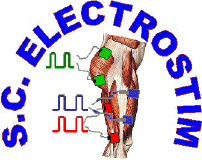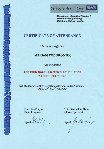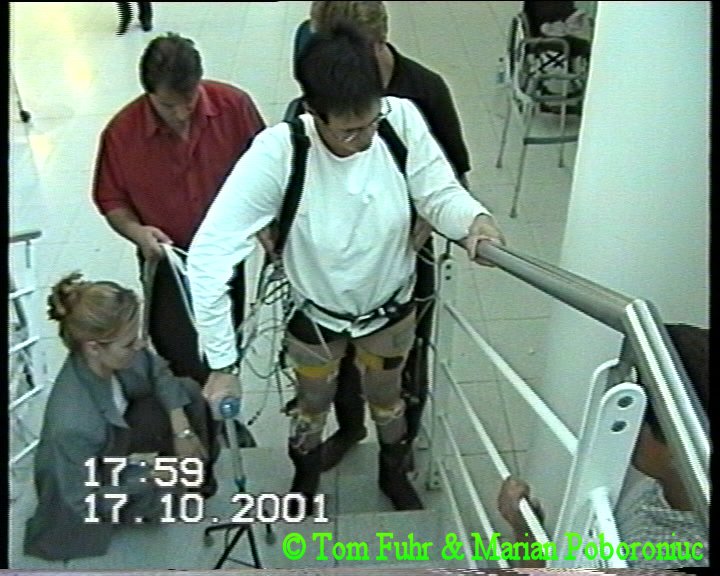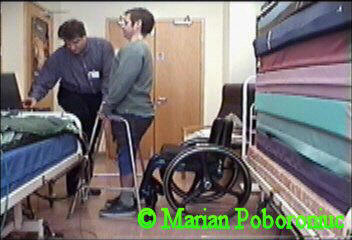|
|
|
||
|
Tel: +40
232 437273 / +40 729 951563 E-mail: mpobor@ee.tuiasi.ro |
Dr. Marian S. Poboroniuc is an accredited trainer of the
approved training FES courses within the Depatment of Medical Physics and
Biomedical Engineering ( |
Certificate of Attendance. FES-Single-Channel Course |
Certificate
of Attendance. |
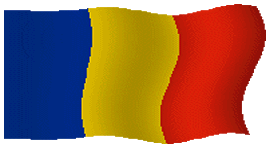
Versiunea
in limba romana
FUNCTIONAL ELECTRICAL STIMULATION
People who have suffered injury of the spinal cord often
become paralyzed. Since the nerve pathways from the brain to the lower
extremities are unrecoverably damaged they can no longer be controlled.
Functional Electrical Stimulation
(FES) is a technology for restoring body functions
through artificial electrical stimulation of the neuromuscular system.
Specifically, this technology can support the restoration of mobility in
paralyzed individuals.
Potentially, many paralyzed individuals can benefit from FES systems: in
Europe there are many thousands of new cases of Spinal Cord Injury (SCI) every year. Most of these individuals
are young people (60% between 18 and 30 years) in their most productive years. Apart
from the SCI population, FES is also applicable in part of the stroke, Multiple Sclerosis and Cerebral Palsy population.
Therapeutic stimulation. Therapeutic
electrical stimulation is a form of treatment, and is therefore usually carried
out under supervision. The benefits form therapeutic electrical stimulation may
include: improved muscle tone, strength, reduced spasticity, improved limb
blood flow, or a reduction in disuse.
Functional electrical
stimulation. FES aims to produce movements or functions which mimic normal voluntary
movements, and so to restore functions which those movements serve. The FES
devices are under the subject's control and should be available when required
during the day's activities at home and elsewhere, rather than being located in
a place for 'treatment'. FES equipment must be portable, reliable, and easy to
use.
Much work has been done in the field of FES world wide, but one of the
largest clinical applications of FES is found in Salisbury
District Hospital, Department of Medical Physics and Biomedical Engineering,
England. They have up to now seen more
than 1500 patients, trained more than 600 clinicians, and employ an active Research and
Development programme. Clinics have been established in all parts of the UK and
in S. Ireland, Belgium, Italy, Spain, Denmark, Holland, South Africa and Hong
Kong. Their clinical service began in 1994, and they currently employ Clinical
Engineers, Physiotherapists, Occupational therapists and technicians to this
end. The following is a list of the Stimulators designed in Salisbury, under
the Department of Medical Physics, together with their applications. All
systems are CE marked, and are BSI (British Standards Institution) Registered.
|
|
|
|
The Odstock Dropped Foot Stimulator (ODFS) is a single channel, foot switch triggered stimulator designed to elicit dorsiflexion and eversion of the foot by stimulation of the common peroneal nerve, (max. amplitude 100mA, 350µs pulse, 40 Hz). |
|
|
|
|
|
The MICROSTIM2 stimulator covers the need for therapeutic exercise stimulation arose in the clinical environment, to augment the functional stimulation work. It has two channels of stimulation, able to deliver various frequencies and independent intensities via surface electrodes. The current uses of exercise stimulation include:
|
The O4CHS stimulator could be seen as a a 4-channel version of the Microstim 2. Uses include:
It is also a useful aid to Physiotherapy re-education of movements, when using a “Wow-pedal”. This enables the therapist to bring on the stimulation using a foot pedal, to encourage synergistic muscle activation in conventional physiotherapy treatments. |
Neural Prostheses
The purpose of a
neural prosthesis is to restore lost or
impaired body functions by electrical stimulation of the peripheral nervous
system. Where the central nervous system has been
damaged (e.g. by SCI or stroke), peripheral stimulation can bridge the gap
created by the loss of communication between the central command centre and the
working parts of the human machine.
Despite many investigations performed so far, FES-supported standing-up
(SU), walking and sitting-down (SD) strategies and devices used outside the
clinic remain a great challenge. The control of multiple joints is difficult
due to the complexity, nonlinearity, and time-variance of the system (human
body) involved. Furthermore, effects such as muscle fatigue, spasticity, and
limited force in the stimulated muscle further complicate the control task.
FES-supported SU and SD strategies are prerequisites for independent standing
and upright mobility.
Based on patient needs and the desired comfort in lower extremity FES
applications, some objectives in control of FES-supported SU and SD have been
identified:
-
Avoid overstress
due to high deceleration
-
Minimise the hand
forces exerted by the patient
-
Assure a
comfortable movement velocity
-
Reduce the
metabolic energy consumption
- Use a simple controller, that is acceptable for patients and physiotherapists.
Activities and results within Research Training Network
Neural Prostheses (NeuralPRO - HPRN-CT-2000-00030)
Technical University of Munich, Center of Automation and Autonomous
Systems, Germany
Main research goal consists in design, verify and evaluate control strategies for assisted standing, standing up and sitting down in paraplegia using surface stimulation. A new control strategy (ONZOFF control) for FES-supported standing-up and sitting-down in paraplegia was developed and tested in some experiments. The new proposed control strategy was implemented into the WALK! neuroprosthetic system (TU Munich).
|
|
|
|
Proposed ONZOFF Control Strategy |
Experimental trials - Grosshadern Hospital Munich, Germany |
|
|
|
|
WALK! Neuroprosthetic system - Grosshadern
Hospital Munich - Walking tests - supervisors Dr. Tom Fuhr & Dr. Robert
Riener (complete thoracic SCI subject - Lesion: T9) |
|
University College London & Salisbury District Hospital, UK
1. Study of existent
application programs implemented into STANMORE Stimulator.
2. Proposed a new application program (CLSTDSD.C) for the Stanmore Stimulator. It implements Standing-Up (SU), Standing and Sitting-Down (SD) FES-based control strategies in paraplegia. Standing-up motion task is performed by ramping-up the pulse width of stimulated group of muscle (quadriceps). PID based design control strategy [Woo98] or KEC (knee extension controller) strategy [Fuhr01] are used in standing. For SD there are three FES-based control strategies taken into account: open-loop control (ramping-down the pulse width of stimulated group of muscle), On/Off control [Mul92] and ONZOFF control [Pob02-1,2]. The proposed application program allow the choose of any control strategy for a particular motion task within a chained motion SU-Standing-SD.
3. A Matlab GUI (Graphic User Interface) and the afferent programs plotting the experimental data when using different FES-based control strategies for a chained motion SU-Standing-SD was developed.
|
|
|
|
|
|
Bibliography
[Fuhr01] Fuhr, T., Riener, R., Schmidt, G. (2001) Walk! -
Experiments with a Cooperative Neuroprosthetic System for the Restoration of
Gait, Proc. 6th Conference of the International Functional Electrical
Stimulation Society (IFESS), Cleveland, OH, USA,June 2001,p.1-3.
[Mul92] Mulder, A. J., Veltink, P. H., Boom, H. B. K.
(1992) On/off control in FES-induced standing up: A model study and
experiments, Med. Biol. Eng. Comput., 30, 205-212.
[Pob02-1] Poboroniuc, M.S., Fuhr., T., Riener, R., Donaldson,
N. (2002) Closed-Loop Control for FES-Supported Standing-Up and Sitting-Down,
Proceedings of the 7th Annual IFESS Conference, Ljubljana, Slovenia, 307-309.
[Pob02-2]. Poboroniuc, M.S., Fuhr, T., Wood, D., Riener,
R., Donaldson, N. 2002. FES-Induced Standing-Up and Sitting-Down Control
Strategies in Paraplegia. FESnet Conference 2002, September 2nd-3rd, Glasgow,
UK, pp.1-3.
[Pob03] M. Poboroniuc, Wood D., Donaldson, N., Fuhr., T.,
Riener, R., Closed-Loop Control for FES-based Restoration of Standing in
Paraplegia, 2nd World Congress of the International Society of Physical and
Rehabilitation Medicine-ISPRM, pp.201-204, Prague, Czech Republic, May 18-22,
2003.
[Woo98] Wood, D. E., Harper, V.J., Barr, F.M.D., Taylor,
P.N., Phillips, G.F., Ewins, D.J., Experience in Using Knee Angles as part of a
Closed-loop Algorithm to Control FES-Assisted Paraplegic Standing. 6th Vienna
International Workshop on Functional Electrostimulation: Basics, Technology,
Application, September 22-24, 1998.
